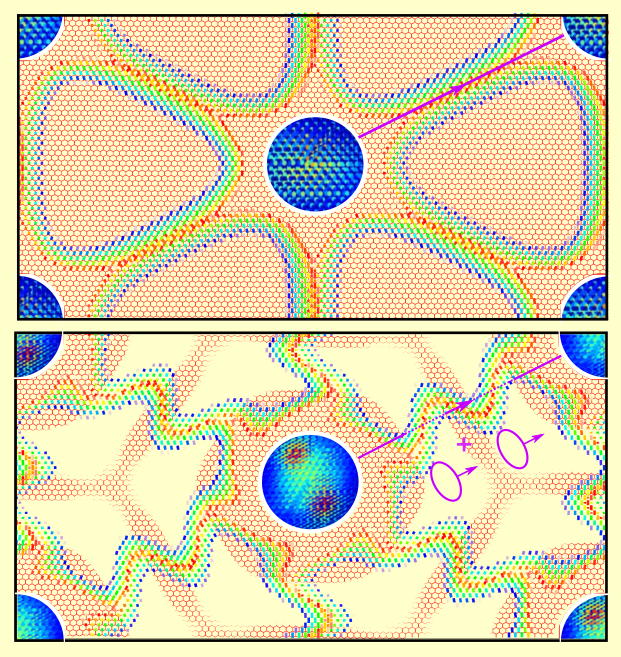Magic angle twisted bilayer graphene has emerged in the past decade as a platform for non-conventional superconductivity. This behavior arises in the presence of a localized flat band as the twist angle approaches a well-defined value referred to as the
magic angle, shown in a pioneering theoretical work [1]. This theoretical prediction was later confirmed by experiments [2], giving more details on the superconducting behavior of magic angle twisted bilayer graphene. Of particular interest is the observed symmetry breaking between hole and electron doping that is characteristic of this type of superconductivity.

Figure 1: Top views of a magic angle twisted bilayer graphene super-cell.
The red honeycomb lattice is the upper graphene layer shadowed by a plain yellow plane positioned at the average mid-distance between the two graphene layers. The color dots highlight the core of the helical dislocation [4] as revealed by the bond convolution [5] between the two layers. The central spot of the super-cell, is overlaid by orbital projected density map close to the Fermi level [3] : with the helical dislocation, that results from the reconstruction of the screw segment with purple edge loops, the spot presents a broken symmetry due to half filled bands [5].
Interestingly, this critical symmetry breaking is absent in a
simple single-particle model of a flat twisted bilayer graphene structure containing pure screw van-der-Waals dislocation segments between the moiré spots. In a series of two papers [3, 4] we showed that to recover the requisite symmetry breaking while keeping the physics simple, one needs only to add a dislocation edge loop to the initial screw dislocation (purple lines on figure 1a). As a result, a mixed dislocation associated with a helical topology is stabilized. The helicity of the core is genuinely 3D [4] and gives rise to an out-of-plane displacement as highlighted on
figure 1b.
This topology drives the Fermi level away from the charge neutrality point, causing partially filled flat bands in magic-angle [3]. This deformation also causes a charge redistribution in the twisted bilayer, causing a particular broken symmetry (central inset in
Figure 1) typically observed in high temperature superconductors and reported in magic-angle tBLG. Our findings also explain several exciting experimental observations in magic-angle tBLG, including striped charge order and evolution of the vibrational spectra, neither of which can be explained in terms of the conventional deformation mode with pure screw dislocations.
Our understanding of moiré physics deriving from dislocation concepts makes it possible to rationalize these and many other observed features within a well-established framework [5]. Additional findings may yet emerge from this dislocation model for the moiré structure in tBLG. Indeed, while solitons provide one simple framework for understanding moiré patterns, there is no comparable concept of helical solitons…but helical dislocations have been observed in materials for more than seven decades!